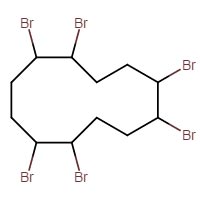Cyclic aliphatic bromides cluster (HBCD)
TSCA Ten: Snapshots of the first 10 chemicals to be reviewed under the new TSCA
Summary: An overhaul in 2016 of the main U.S. chemical safety law, the Toxic Substances Control Act, required EPA to choose the first 10 chemicals for risk evaluation. HCBD, one of the first 10 chemicals, is a flame retardant chemical used in foam, textiles, and electronics. It is highly toxic to fish and other aquatic species.
What kinds of products may use it?
- Expanded and extruded polystyrene foam (EPF and XPS respectively)
- Foam boards and insulation
- Textiles1
- High impact polystyrene (HIPS), which can be found in:
- Toys
- Plastic cups
- Shipping and packing material
- Refrigerator linings
- TVs and other audio-visual equipment
- Wire and cable applications
What hazards does it pose?
- Developmental toxicity
- Aquatic toxicity (both acute and chronic)
- Liver toxicity
- Bioaccumulative (builds up in the body)
- Persistent in air, water, and soil
Who may be exposed or most at risk?
- Workers and occupational bystanders in HBCD manufacturing and processing industries or using commercial products containing HBCD
- Consumers using products containing HBCD
- Pregnant women/ developing fetus/children
- People that depend on water sources contaminated with 1,4-dioxane
- People that live in environments contaminated with 1,4-dioxane
Production profile (2015)
- U.S. manufacture (production and import): Between 1 and 10 million pounds
- Number of manufacturers: 3
- Number of manufacturing sites: 4
What industries use it?
- Polystyrene manufacturing
- Construction materials manufacturing, especially roofing and insulation
- Textile, especially for auto and carpet industries
HBCD additional resources
Chemical snapshot

HBCD can be found in some car seats made with polystyrene foam.

Credit: Chem ID Plus data base under the U.S. National Library of Medicine.










